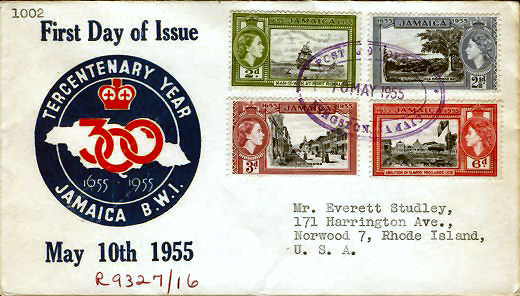![]()
Postal History Introduction
Stampless
Covers
1846
to 1900 Issues
1901-1950
Issues
1951-2003
Issues
Cancels
&
Miscellaneous
Postal
Stationery
Post
Cards
Air
Mail
First
Day &
Event Covers
Parcel Post/Special Delivery
Registered & Official Mail
Commercial & Advertising
Revenue & Postage Due
Wildlife & Game Issues
Complete List of RI Issues
|
Rhode Island Around the
World - International Mail |
|
|
|
|
The Registered "First Day of Issue" Cover above was postmarked Kingston, Jamaica on May 10, 1955 and sent to Mr. Everett Studley in Providence, RI. The reverse of the cover, (SEE: Full Size Reverse of Cover with receiving postmarks) contains a Providence Registry Division postmark dated May 12 and an Elmwood Station postmark dated May 13. The stamps are the 2-pence, 21/2-pence, 3-pence, and 6-pence tercentenary issues of 1955 (Stanley Gibbons #s 155, 156, 157, and 158) and depict respectively; "Man of War at Port Royal," "Old Montego Bay," "Old Kingston," and "Abolition of Slavery Proclaimed 1838." Each of the stamps bear a portrait of Queen Elizabeth II and the dates 1655 - 1955. They are tied to the cover with a Kingston Oval Date Stamp. BWI stands for "British West Indies." JAMAICA Jamaica was originally settled by the Arawak Indians from South America about 2,500 years ago. They named the island Xaymaca, (Land of Wood and Water). Christopher Columbus landed in Jamaica on May 5, 1494 and claimed the island for Spain. The Spanish controlled the island until May 10, 1655 when an English Armada under Admiral William Penn and General Robert Venables attacked and successfully captured the island. The original English settlement was at Port Royal, which became famous because of its Buccaneers. One of the most famous of these was Sir Henry Morgan, who began his career as a pirate and later became Lieutenant governor of Jamaica in 1673. On June 7, 1693 an earthquake destroyed Port Royal and the survivors resettled in Kingston. In 1958 the "Federation of the West Indies" was formed by ten Caribbean countries including Jamaica, however the Jamaicans voted against joining the Federation in 1961 and on August 6, 1963 Jamaica became an independent nation and a member of the Commonwealth. Jamaica is located south of Cuba and is approximately the size of the state of Connecticut. The majority of the population, (90%) is of African heritage with (7%) of mixed heritage. The economy is service based with most of it's foreign exchange deriving from tourism. |
![]()
RI Historical
Society
The Post Offices
Home Page
RI Tercentenary Issue History
RI Philatelic Society
Recently Added Pages
Philatelic Primer
Rhode Island Around the World
Rhode Island
Town Postmarks
Other Websites of Interest
